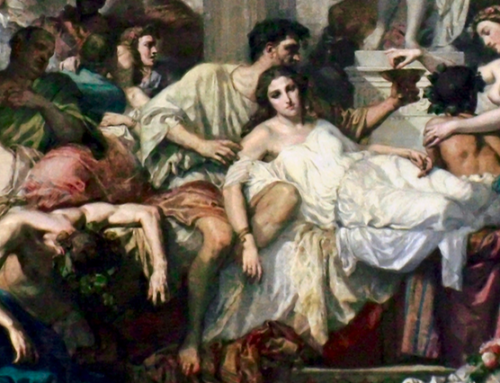Somewhere, the Sage hath said, Philosophy is easy; plumbing is hard. The Sage is correct; we should be suspicious of systems that exist only in the mind, but are never seen on the ground. It is only on the ground that they can be tested, and on those grounds alone we should take our stand. It is easy—too easy—to come up with abstract systems which are perfection itself; it is much harder to make them work. The problem with abstract theorizing is that creating theories is a selection process; one must decide what to leave in a what to take out. But one can never know that the right elements have been included without seeing how the system works in practice. Hence, practice alone is the only standard of judgment about social systems.
In Chapter II we noted the failure to Capitalism to live up to its own standards, to deliver what it promises. We noted that it always and everywhere ends up with a statist economy, ever more dependent on government interventions. But such a critique would ring hollow if Distributism did not have its own practice which the capitalist could examine in the same way we have examined capitalism. Fortunately, there are many long-standing examples of distributist economies and practices, and their problems and successes can be examined in as much detail as you like; we can see whether the theory describes an actual practice, and whether the practice works as advertised. Here I will mention only of the more prominent examples, and I invite the reader to examine them in greater detail for himself.
The Mondragón Cooperative Corporation (MCC). Recently, the workers in the Fagor Appliance Factory in Mondragón, Spain, received an 8% cut in pay.[1] This is not unusual in such hard economic times. What is unusual is that the workers voted themselves this pay cut. They could do this because the workers are also the owners of the firm. Fagor is part of the Mondragón Cooperative Corporation, a collection of cooperatives in Spain founded over 50 years ago.
The story of this remarkable company begins with a rather remarkable man, Fr. José Maria Arizmendiarrieta, who was assigned in 1941 to the village of Mondragón in the Basque region of Spain. The Basque region had been devastated by the Spanish Civil War (1936-1938); they had supported the losing side and had been singled out by Franco for reprisals. Large numbers of Basque were executed or imprisoned, and poverty and unemployment remained endemic until the 1950’s. In Fr. José’s words, “We lost the Civil War, and we became an occupied region.”[2] However, the independent spirit of the Basques proved to be fertile ground for the ideas of Fr. José. He took on the project of alleviating the poverty of the region. For him, the solution lay in the pages of Rerum Novarum, Quadragesimo Anno, and the thinkers who had pondered the principles these encyclicals contained. Property, and its proper use, was central to his thought, as it was to Pope Leo and to Belloc and Chesterton. “Property,” Fr. José wrote, “is valued in so far as it serves as an efficient resource for building responsibility and efficiency in any vision of community life in a decentralized form.”[3]
Fr. José’s first step was the education of the people into the Distributist ideal. He became the counselor for the Church’s lay social and cultural arm, known as “Catholic Action,” and formed the Hezibide Elkartea, The League for Education and Culture, which established a training school for apprentices. He helped a group of these students become engineers, and later encouraged them to form a company of their own on cooperative lines. In 1955, when a nearby stove factory went bankrupt, the students raised $360,000 from the community to buy it. This first of the co-operatives was named Ulgor, which was an acronym from the names of the founders.
From such humble beginnings, the cooperative movement has grown to an organization that employs over 100,000 people in Spain, has extensive international holdings, has, as of 2007, €33 billion in assets (approximately US$43 billion), and revenues of €17 billion. 80% of their Spanish workers are also owners, and the Cooperative is working to extend the cooperative ideal to their foreign subsidiaries.[4] 53% of the profits are placed in employee-owner accounts. The cooperatives engage in manufacturing of consumer and capital goods, construction, engineering, finance, and retailing. But aside from being a vast business and industrial enterprise, the corporation is also a social enterprise. It operates social insurance programs, training institutes, research centers, its own school system, and a university, and it does it all without government support.
Mondragón has a unique form of industrial organization. Each worker is a member of two organizations, the General Assembly and the Social Council. The first is the supreme governing body of the corporation, while the second functions in a manner analogous to a labor union. The General Assembly represents the workers as owners, while the Social Council represents the owners as workers. Voting in the General Assembly is on the basis of “one worker, one vote,” and since the corporation operates entirely form internal funds, there are no outside shareholders to outvote the workers in their own cooperatives. Moreover, it is impossible for the managers to form a separate class which lords it over both shareholders and workers and appropriates to itself the rewards that belong to both; the salaries of the highest-paid employee is limited to 8 times that of the lowest paid.
Mondragón has a 50 year history of growth that no capitalist organization can match. They have survived and grown in good times and bad. Their success proves that the capitalist model of production, which involves a separation between capital and labor, is not the only model and certainly not the most successful model. The great irony is that Mondragón exemplifies the libertarian ideal in a way that no libertarian system ever does. While the Austrian libertarians can never point to a working model of their system, the Distributists can point to a system that embodies all the objectives of a libertarian economy, but only by abandoning the radical individualism of the Austrians in favor of the principles of solidarity and subsidiarity.
The Cooperative Economy of Emilia-Romagna. Another large-scale example of Distributism in action occurs in the Emilia-Romagna, the area around Bologna, which is one of 20 administrative districts in Italy. This region has a 100 year history of cooperativism, but the coops were suppressed in the 1930’s by the Fascists. After the war, with the region in ruins, the cooperative spirit was revived and has grown ever since, until now there are about 8,000 coops in the region of every conceivable size and variety. The majority are small and medium size enterprises, and they work in every area of the economy: manufacturing, agriculture, finance, retailing, and social services.
The “Emilian Model” is quite different from that used in Mondragón. While the MCC uses a hierarchical model that resembles a multi-divisional corporation (presuming the divisions of a corporation were free to leave at any time) the Emilian model is one of networking among a large variety of independent firms. These networks are quite flexible, and may change from job to job, combining a high degree of integration for specific orders with a high degree of independence. The cooperation among the firms is institutionalized many in two organizations, ERVET (The Emilia-Romagna Development Agency) and the CNA (The National Confederation of Artisans).
ERVET provides a series of “real” service centers (as opposed to the “government” service centers) to businesses which provide business plan analysis, marketing, technology transfer, and other services. The centers are organized around various industries; CITER, for example, serves the fashion and textile industries, QUASCO serves construction, CEMOTOR serves earth-moving equipment, etc. CNA serves the small artigiani, the artisanal firms with fewer than 18 employees, and where the owner works within the firm, and adds financing, payroll, and similar services to the mix.
We discussed in Chapter 16 how the cooperatives work as an industrial model. Here let us only add that that the Emilian Model is based on the concept of reciprocity. Reciprocity revolves around the notion of bi-directional transfers; it is not so much a defined exchange relationship with a set price as it is an expectation that what one gets will be proportional to what one gives. The element of trust is very important, which lowers the transaction costs of contracts, lawyers, and the like, unlike modern corporations, where such expenses are a high proportion of the cost of doing business. But more than that, since reciprocity is the principle that normally obtains in healthy families and communities, the economic system reinforces both the family and civil society, rather than works against them.
Space does not permit me to explore the richness of the Emilian Model. I will simply note here some of its economic results. The cooperatives supply 35% of the GDP of the region, and wages are 50% higher than in the rest of Italy. The region’s productivity and standard of living are among the highest in Europe. The entrepreneurial spirit is high, with over 8% of the workforce either self-employed or owning their own business. There are 90,000 manufacturing enterprises in the region, certainly one of the densest concentrations per capita in the world. Some have called the Emilian Model “molecular capitalism”; but whatever you call it, it is certainly competitive, if not outright superior, to corporate capitalism.
Taiwan and the “Land to the Tiller” Program. In 1949, the Chinese Nationalists were defeated by the Communists and fled to the island of Formosa, now called Taiwan. The Taiwan that greeted the refugees was a feudal backwater. Mostly it was a nation of small sharecroppers paying rents of 50-70% of the crop. Most of the land was owned by members of just 20 families. Further, since the returns on land were so high that there was little interest in investing in industry. In addition, Taiwan had to absorb 2 million refugees from the mainland and bear the costs of defense. It was expected that Taiwan would soon fall to the mainland communists, as the Kuomintang had never proved very effective in controlling China. It was necessary to act quickly to reform Taiwan; it was the very failure to enact reforms which had made the Kuomintang unpopular in China and led to the victory of the Communists. They could not make the same mistake twice.
Effective control of the non-Communist East was in the hands of General Douglas MacArthur, who happened to be a distributist. He worked out a plan of reform for Korea, Japan, and Taiwan. Here we deal just with the reforms in Taiwan. The basis of the plan is that the farmers who actually worked the land would come into possession. The landowners were forced to sell the land to their tenants at a price equal to 2.5 times the average crop. The farmers paid for the land over 10 years. Under this “land to the tiller” program, 432,000 families came into possession of their own land. Where previously they had been paying 50% forever, now they would pay 25% for 10 years.
The results were dramatic. Since farmers got the full rewards of their labor, they were more willing to invest more money and give more labor. Farm production increased as farmers used more fertilizer, went to multiple cropping with as many as four crops/year and diversified production to higher value but more labor intensive crops. Production increased at an annual rate of 5.6% from 1953 thru 1970. The farmers suddenly had something they never had before: relatively large amounts of disposable income. Now they needed some place to spend it. Providing products to buy would require an expansion of industry on the island, if the country was not to be dependent on imports.
Most of the payments to the landowners was not in the form of cash, but in bonds. These bonds were negotiable industrial bonds which the former landlords could invest in any light industry they chose.5 Indeed, there was nothing else they could do with the bonds; it was a case of “invest or die.” The strategy was twofold: get capital, in the form of land, into the hands of farmers; get capital, in the form of industrial investment, in the hands of entrepreneurs. Note that the strategy provided both goods to buy and purchasers to buy them; it was a binary strategy, giving equal weight to production and consumption. A tremendous number of capitalists were created overnight; the former landowners, who previously had no interest in manufacturing, were converted into instant urban capitalists and had to find places to invest the proceeds from the lands sales; the landless peasants became proprietors. By this method, the government provided support to Taiwan’s fledgling industrial base. But the fact that the actual companies to invest in were picked by the former landowners meant better investment decisions than if the government had tried to pick the winners itself. Industrial production expanded, giving the newly empowered peasants some place to spend the money buying locally produced goods.
We can see the Taiwanese experiment for the conjuring trick it was: the government sold land it didn’t own, bought with money it didn’t have and financed industries that didn’t exist; the government managed to both expand the consumer market and to provide the industrial production necessary to serve that market and serve it from local resources. There was no inflation because the money supply expanded at the same rate as production by a sort of automatic method. Redistribution allowed for expansion of the consumer base which allowed for expansion of the industrial base. It is not often in business and economics that one gets to see solutions which are elegant and beautiful, but certainly the land to the tiller program qualifies.
The results have been impressive, both in economic and social terms. Starting with crude products made in small workshops, Taiwan followed the industrial value-added food chain right shipbuilding, electronics, and every sort of industry. Taiwan has managed 50 years of high growth rates, increased equality, and low tax rates (comparatively). Unemployment was low to non-existent through most of Taiwan’s post war history. Before 2000, it rarely exceeded 3% and usually was less than 2%. Since 2000, the rate has risen as high as the low 5’s before dropping back to the 4% range as Taiwan struggles to adjust to outsourcing to mainland China. By human measures, Taiwan’s growth was also a great success. For example, the literacy rate increased from 45% in 1946 to 93% in 1989; life expectancy went from 59 years in 1952 to 74 years in 1989 while the per capita caloric intake went from 2,078 calories to 3,070 in the same period. Living space per person went 4.6 square meters to 23.8.6 Further, Taiwan and the other “Asian Tigers” were able to achieve these successes despite having population densities among the highest in the world, a fact which contradicts the prevailing dogma that population density is an impediment to growth.
Other Examples. There are many other functioning examples of Distributism in action: micro-banking, Employee stock option plans, mutual banks and insurance companies, buyers and producers cooperatives of every sort. This sample should be enough how distributism works in practice. Distributists are often accused of being “back to the land” romantics. The truth is otherwise. There are no functioning examples of a capitalism which operates anywhere near its own principles; there couldn’t be, because the mortality rates are simply too high. Hence, capitalism always relies on government power and money to rescue it from its own excesses. Distributism goes from success to success; capitalism goes from bailout to bailout.
Books by John Médaille and on distributism are available in The Imaginative Conservative Bookstore. This is part V of Dr. Médaille’s series on the Economics of Distributism. Click here for parts I, II, III, IV. This originally ran on Front Porch Republic and is published here with the permission of the author. The Imaginative Conservative applies the principle of appreciation to the discussion of culture and politics—we approach dialogue with magnanimity rather than with mere civility. Will you help us remain a refreshing oasis in the increasingly contentious arena of modern discourse? Please consider donating now.
Notes
1. “All in this together,” Economist.com, March 26, 2009
2. R. Matthews, Jobs of Our Own: Building a Stakeholder Society (Sydney, Australia and West Wickham, UK: Comerford and Miller, 1999), 184
3. Ibid., 185
4. Mondragón Cooperative Corporation, “2007 Annual Report,” December 31, 2007,
5. J. Jacobs, Cities and the Wealth of Nations: Principles of Economic Life (New York: Random House, 1985), 100
6. S.W.Y. Kuo, “Economic Development of the Republic of China on Taiwan,” in Agriculture on the Road to Industrialization (Baltimore: John Hopkins University Press, 1995), 334








I have waited for the completion of this series to make any response to the rather excellent comments, most of which stand on their own and require no comment from me. But I would like to offer just a short observation on the comment that it is all "radical and ideological." And my comment is this: I hope it is the former and I'm sure it's not the later.
We have run out of time, and nothing short of the radical remains. Chesterton once said, "If we move quickly, we shall have time to go slowly." We did not move and we are out of time. Looking at our situation, we have, by the optimistic U3 numbers, 15 million unemployed. In the next three years, we will need another 6 million jobs, just to absorb the new entrants into the job market. But under current institutional arrangements, there simply is no source for that number of jobs, not in an economy that has outsourced so much of its production, without getting much in exchange aside from cheap crap at WalMart. I think we are in an endgame, when the only rational person is the radical.
As for ideology, I think the very variety of distributive systems answers that charge; it is not ideological but adaptable to different circumstances and cultures. Unless the commenter means something else by "ideological" which I just am not getting.
I can understand why conservatives especially in America, are so fond of Un-controlled capitalist markets. It is because anyone who tries to be an authentic conservative is told they have to be a libertarian to a certain extent. What I don’t understand is Dr Birzer’s (with all due respect) unwillingness to bring his Catholicism out of the private realm, if he did I suspect he would understand that Christianity is radical and conservative at the same time. But yet no one is perfect. I’m guilty of it as much as anyone else.